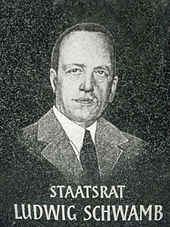Ludwig Schwamb
Ludwig Schwamb (born July 30, 1890 in Undenheim , † January 23, 1945 in Berlin-Plötzensee ) was a lawyer , social democratic politician and close collaborator of Wilhelm Leuschner . As a Christian motivated member of the " Kreisau Circle ", Schwamb fought against the National Socialist dictatorship and was involved in the failed attempt at overthrow of July 20, 1944 .
Life
Ludwig Schwamb came from a rural Rhine - Hessian family. After graduation in Mainz , he studied in Giessen law . Here he became a member of the Landsmannschaft Darmstadtia student union . A brief settlement as a lawyer was followed by a career in administration; In 1921 he became a government assessor at the Alzey tax office and in 1925 a senior councilor in Oppenheim .
In 1923 he married his Elisabeth Schwamb .
After the trade unionist Wilhelm Leuschner became Minister of the Interior in the then people's state of Hesse in 1928 , Schwamb moved to the state capital Darmstadt as its personal advisor . There he worked closely with Leuschner's press officer, who later became a member of the Reichstag, Carlo Mierendorff , and was quickly promoted to ministerial councilor and in 1928 to state councilor at the Darmstadt Administrative Court .
In 1933 Ludwig Schwamb was removed from office by the National Socialists and was then under police supervision. He tried in vain to set up a law firm in Mainz and moved to Berlin, where he worked as the syndic of the Tack shoe factory .
After Leuschner, Mierendorff and other leading social democrats were released from protective custody and concentration camps , Schwamb's apartment developed into a conspiratorial meeting place for resistance fighters. They also included Julius Leber , the journalist Emil Henk (1883–1969) from the Heidelberg / Mannheim area , the co-founder of the Reichsbanner Schwarz-Rot-Gold Theodor Haubach , who was born in Frankfurt , and from 1940 after his release from the Dachau concentration camp , also the later Rhineland-Palatinate Interior and Social Affairs Minister Jakob Steffan (1888–1957).
Like Leuschner and Mierendorff, Schwamb was later a member of the Kreisau Circle , a non-partisan resistance group that met on the Kreisau estate of Helmuth James Graf von Moltke in Lower Silesia . While Wilhelm Leuschner was among the conspirators of July 20 as the future Vice Chancellor, if not later as Chancellor or even as Head of State, Ludwig Schwamb, as political representative in military district XII (Wiesbaden) , i.e. in the area between Kassel and Heidelberg, was to be the opposition Coordinate forces. He was supposed to mobilize the local, primarily social-democratic-trade union resistance groups, not least to prepare a general strike. In addition, he had to ensure the coordination of the particularly dense conspiratorial stewards network in the Rhine-Main region with the military wing of the resistance so that a democratic and social order could have been prepared in the Hesse / Rhineland-Palatinate area.
Ludwig Schwamb was arrested three days after the failed assassination attempt on July 20, 1944 in Frankfurt am Main. After months of imprisonment in the Lehrter Strasse cell prison , he was sentenced to death by the People's Court under Hitler's “ blood judge ” Roland Freisler on January 13, 1945 and hanged together with nine other people involved on January 23, 1945 in Plötzensee .
On January 31, 1945, Schwamb's wife Elisabeth - informally and without address - was informed of the death sentence and its execution with the passage: “The publication of a death notice is not permitted”.
memory
The Schwambzeile was named after him near the Plötzensee execution site.
Several memorials, streets, squares and schools are a reminder of Ludwig Schwamb's life and work.
literature
- Emil Henk : The tragedy of July 20, 1944 . Heidelberg 1945 (2nd extended edition 1946).
- Ludwig Schwamb . In: Franz Osterroth : Biographical Lexicon of Socialism . Volume 1: Deceased Personalities. Verlag JHW Dietz Nachf. GmbH, Hanover 1960, p. 283.
- Annedore Leber u. a. (Ed.): The conscience stands up. Life pictures from the German resistance 1933–1945 . Mainz 1984.
- Hans-Adolf Jacobsen (ed.): Mirror image of a conspiracy. The opposition to Hitler and the coup d'état of July 20, 1944 in the SD reporting. Secret documents from the former Reich Security Main Office . Stuttgart 1984 (2 volumes).
- Christina Stein: Ludwig Schwamb - a Rheinhessen resistance fighter against the National Socialist dictatorship, in: Mainzer Geschichtsblätter, Issue 15: Biographies in times of dictatorship 1933-1945, Mainz 2014 (publications by the Mainz Social History Association), pp. 209-231.
- Axel Ulrich: Political resistance against the "Third Reich" in the Rhine-Main area . 3. Edition. Wiesbaden 2008, ISBN 978-3-9809513-2-6 .
- Axel Ulrich: Ludwig Schwamb, Jakob Steffan and other southwest German comrades-in-arms of Wilhelm Leuschner in the anti-Nazi resistance . In: Niersteiner history sheets . tape 12 , 2006, p. 21-50 .
Web links
- Short biography of the German Resistance Memorial Center
- Schwamb, Ludwig in the Hessian Biography , as of January 23, 2017
- Peter Engels: Schwamb, Ludwig. In: Stadtlexikon Darmstadt
- Anton Maria Keim : The fight against Hitler cost him his life ( Memento from March 16, 2005 in the Internet Archive ). In: Main-Rheiner , January 22, 2005 (on Schwamb's role in the resistance in the Rhine-Hesse region).
Individual evidence
- ↑ Schwambzeile. In: Street name lexicon of the Luisenstädtischer Bildungsverein (near Kaupert )
| personal data | |
|---|---|
| SURNAME | Schwamb, Ludwig |
| BRIEF DESCRIPTION | Social democratic lawyer and politician, resistance fighter against the National Socialist dictatorship |
| DATE OF BIRTH | July 30, 1890 |
| PLACE OF BIRTH | Undenheim |
| DATE OF DEATH | January 23, 1945 |
| Place of death | Berlin-Plötzensee |


